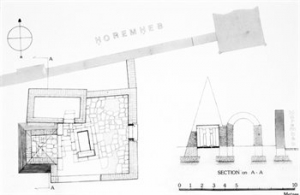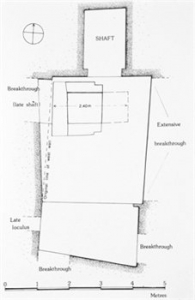General information on Iniuia’s tomb
Iniuia’s tomb was discovered in 1993. This official presumably started his career as a scribe of the state treasury but later became Overseer of the Cattle of Amun and High Steward. He lived during the reign of King Tutankhamun (1333-1323 BC) and must have worked under supervision of the Treasurer Maya. Several details in his tomb’s decoration still remind one of the preceding period of the Amarna heresy, and one inscription even refers to the temple of the sun-god Aten which continued to function for several generations after the death of Akhenaten.

Overview over Iniuia’s tomb
Superstructure of Iniuia’s tomb
Iniuia’s tomb is situated south of that of Horemheb. It was built in mudbrick and measures 9.5 x 8.5 m. It consists of a simple mud-paved courtyard without pylon, peristyle or wall decoration, with an asymmetrical west end comprising a central chapel and an extra painted chapel at the north-west corner. The latter is barrel-vaulted and has well-preserved paintings showing Iniuia offering to Osiris, Horakhte and other gods. The battered walls of the central chapel rose to form a small pyramid of about 6 m high, the tip of which is now in the Louvre. Two columns (in Berlin) helped to carry the weight of this pyramid. Remains of the chapel’s wall-reliefs could be recovered; other parts are in the Cairo Museum, which also holds one of the stelae flanking the entrance to the chapel.

Plan and superstructure of Iniuia’s tomb
Substructure of Iniuia’s tomb
The shaft opening in the courtyard is 7.10 m deep and leads to two chambers (the deepest one situated at about 10 m under courtyard level). Almost nothing could be retrieved of the original burial ensemble, since this complex had been re-used for multiple burials in the Late Period. Iniuia’s beautiful sarcophagus, doubtless from here, has been in the Louvre since the early 19th century.

Substructure of Iniuia’s tomb
Most interesting finds from Iniuia’s tomb
- Shabtis of Pabes, the son of Taditnehmetawy

Shabtis of a Late Period type belonging to Pabes, son of Taditnehmetawy, found in Iniuia’s tomb
In the substructure of the tomb of Iniuia, several remains were found of burials dating to the Late Period and specifically to the 5th century BC. This was the period of Persian rule in Egypt, and for some reason the area of the former New Kingdom necropolis of Saqqara was intensively reused as a burial site. Tombs were no longer individual monuments but communal ones, and consisted of a central chamber with several mummy-niches, accessible via a narrow shaft (often also a reused New Kingdom shaft) and often breaking through into the walls of previous tomb-chambers. The substructure of the tomb of Iniuia was no exception and gave access to various complexes of later date. One of these contained six identical faience shabtis of typical Late Period type. They show the deceased as a mummy with divine wig and beard. A vertical pillar runs over the back, whereas the front is inscribed with the name of the owner: Pabes, the son of Taditnehmetawy.
Iniuia’s family relations

Objects from Iniuia’s tomb in museum collections
- Berlin, Ägyptisches Museum 1627: papyriform column
- Berlin, Ägyptisches Museum 1628: papyriform column
- Boston, Museum of Fine Arts 1977.717: double shabti coffin
- Cairo, Egyptian Museum JE 10079: stela
- Cairo, Egyptian Museum T.25.6.24.7: relief
- Cairo, Egyptian Museum T.3.7.24.13: relief
- Cairo, Egyptian Museum T.14.6.24.29: relief
- Chicago, Art Institute 1894.246: lintel fragment
- Paris, Louvre D 2: sarcophagus
- Paris, Louvre D 14: pyramidion
Bibliography
- Final report:
Schneider, H.D., The Tomb of Iniuia in the New Kingdom necropolis of Memphis at Saqqara (Turnhout 2012).

Preliminary reports:
- Schneider, H.D., et al., ‘The Tomb of Iniuia: Preliminary Report on the Saqqâra Excavations, 1993’, JEA 79 (1993), 1-9.
- Schneider, H.D., ‘The Rediscovery of Iniuia’, EA 3 (1993), 3-5.
Restoration
Immediately after its excavation, the tomb of Iniuia was consolidated by the expediton. To this end, the mudbrick vault of the painted north chapel was reinstated and the perimeter walls of the courtyard and central chapel reinforced. Since no original reliefs remained on the walls (except for a much dilapidated door-jamb), no modern roofing was constructed. No further interventions were made during the 2005-2010 restoration project.

Restoration of Iniuia’s tomb (2005-2010)
